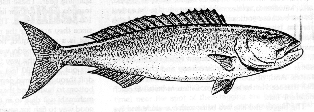- The grey snapper is the
black sheep of the snapper family. All of its cousins are brightly colored fish with hues
ranging from rosy to bright red, occasionally offset with silvers, oranges, and yellows.
- The grey snapper, on the other hand, is about as drably
dressed as a fish can be – light grey with bluish or greenish tints and,
occasionally, slightly darker bars. All of its Hawaiian cousins are shy creatures, hiding
away in the great depths where they are among the deepest-living of Hawaii’s food
fish. The brash grey snapper, however, boldly invades the shallower waters, where it
occasionally comes within reach of shore-casters.
- The grey snapper is a
scrapper. It is a tough-fighting fish that does not give up from the moment it is hooked
until you finally gaff or net it to pull it into the boat. Unlike the rest of the family,
which are gracefully proportioned fish with handsome head profiles, the grey snapper has a
head with a snout almost like a dog’s. The snout even has grooves along each side.
- The grey snapper is
caught year-round, but the best months are May through July.
- Most grey snappers are
caught in water between 180 and 300 feet deep. But the grey snappers are
rule-breakers. They can be caught in sandy channels 5 feet deep and are also caught
trolling small plugs in 15 to 20 feet of water over the reefs.
- And still more grey
snapper have bitten downrigger baits in 60 to 100 feet depths.
- But the places that are
most fun to fish are between 180 and 240 feet deep. The depth is great enough to give you
more grey snapper to catch. And it’s deep enough to discourage many of the smaller
fish that peck away your baits. But it’s not too deep to make you put away your light
tackle and switch to handlines or winches. On calm fishing days, as a matter of fact, I
use spinning tackle and still reach the bottom to hook grey snapper.
- A good
all-purpose fishing rig for grey snapper that is heavy enough to pull up the big ones but
still light enough to have some fun with them, that’s my "meat" rig. It is
a 30-pound-class rod with a high-speed 6/0 trolling reel full of 30-pound test
monofilament line.
- A 10- or 15-pound
grey snapper will put a very good bend in the rod. The line is strong enough to take the
pull of the biggest grey snapper in the ocean (if you set the drag right). The reel is
fast enough to haul up the line quickly between catches when you want to get the hooks
back fast to change baits.
- Heavier line
would be safer to use, of course. That’s because the grey snapper spots are also
places where huge trevally lurk. But the thin line will drop to the bottom quickly with 6
or 8 ounces of lead. Heavy lines require more weight to keep them down.
- When bottom
fishing it is better to use more than one hook, for two reasons. First, there is a lot of
work in getting a line down and back up. It’s nice to have several baits down to make
the elevator ride more worthwhile in case the baits get stolen. Second, fish don’t
feed on the bottom. Some spread out above the bottom. Grey snapper are like that, and it
helps to have hooks in several places.
- I use four
six hooks spread out a few feet apart. The hooks are tied to short leaders no more that 15
inches long and made from 80-pound test nylon. The leaders are tied to three-way swivels.
The swivels are separated by two to three feet 80-pound test mono.
- The bottom swivel
is tied to the sinker by a 2- or 3-foot length of 10-20 pound test nylon. This dropper
loop to the sinker is light enough to break if the sinker gets stuck. The top swivel is
tied to the line.
- Use
Tankichi hooks in size 18 or larger. The size depends on the size of the grey snapper. The
biggest grey snapper weigh nearly 40 pounds and have mouths big enough to swallow marlin
hooks.
|

